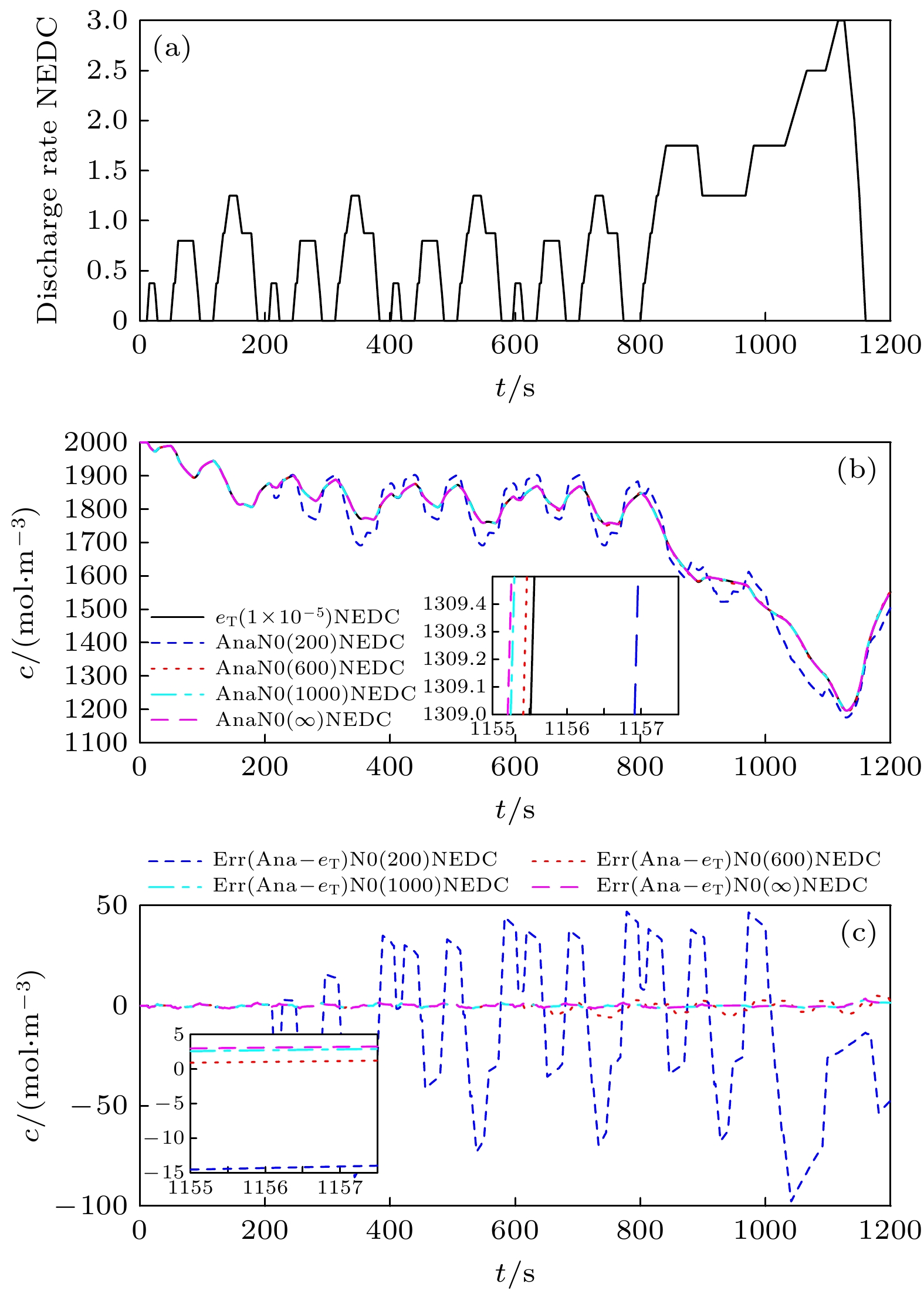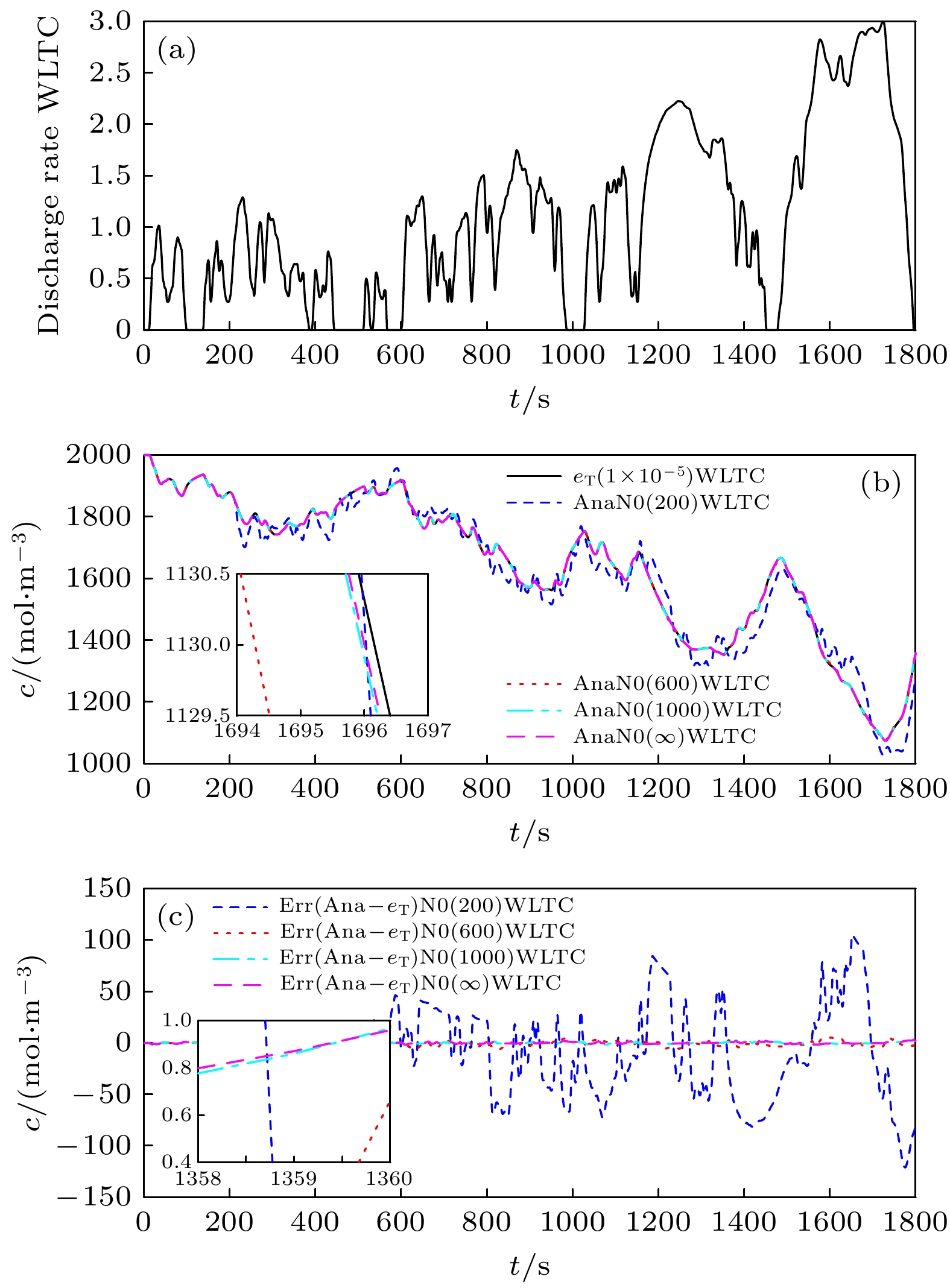-
It is one of basic tasks to solve the electrochemical model of lithium-ion batteries for obtaining the lithium-ion concentration in the electrolyte. In order to balance the computational efficiency and electrolyte dynamic property, it is assumed that reactions occur only at interfaces between the collector and the electrolyte. Based on the analytical solution to the liquid diffusion equations, which is in the form of infinite series, a new method is proposed to solve it. Under galvanostatic profiles, the analytic solution is an infinite time series transformed into a converged sum function by using the monotone convergence theorem. Under the dynamic profiles, the infinite series solution is simplified into an infinite discrete convolution of both the input and the sum function. The sum function is truncated by its characteristic of monotonic decay approaching to zero over time, thus obtaining a finite discrete convolution algorithm. Reference to the results from a professional finite element analysis software, the proposed algorithm can produce high accuracy with less computation time under both galvanostatic profiles and dynamic profiles. Also, there is only one parameter to be configured. Therefore, our algorithm will reduce the computation burden of the electrochemical model applied to a real-time battery management system.
-
Keywords:
- lithium-ion battery /
- electrochemical model /
- electrolyte diffusion /
- sum function /
- finite discrete convolution
[1] Tarascon J M, Armand M 2001 Nature 414 359
 Google Scholar
Google Scholar
[2] Lu L, Han X, Li J, Hua J, Ouyang M 2013 J. Power Sources 226 272
 Google Scholar
Google Scholar
[3] Khumprom P, Yodo N 2019 Energies 12 660
 Google Scholar
Google Scholar
[4] Richardson R R, Birkl C R, Osborne M A, Howey D A 2019 IEEE Trans. Ind. Inf. 15 127
 Google Scholar
Google Scholar
[5] Shen S, Sadoughi M, Chen X, Hong M, Hu C 2019 J. Energy Storage 25 100817
 Google Scholar
Google Scholar
[6] Zhao L, Wang Y P, Cheng J H 2019 Appl. Sci. 9 1890
 Google Scholar
Google Scholar
[7] Lai X, Zheng Y, Sun T 2018 Electrochim. Acta 259 566
 Google Scholar
Google Scholar
[8] Hu X, Li S, Peng H 2012 J. Power Sources 198 359
 Google Scholar
Google Scholar
[9] Cheng X M, Yao L G, Pecht M 2017 J. Zhejiang Univ. -Sci. A 18 256
[10] 李涛, 程夕明, 胡晨华 2021 70 138801
 Google Scholar
Google Scholar
Li T, Cheng X M, Hu C H 2021 Acta Phys. Sin. 70 138801
 Google Scholar
Google Scholar
[11] Chaturvedi N A, Klein R, Christensen J, Ahmed J, Kojic A 2010 IEEE Control Syst. Mag. 30 49
 Google Scholar
Google Scholar
[12] Gu R, Malysz P, Yang H, Emadi A 2016 IEEE Trans. Transp. Electrification 2 417
 Google Scholar
Google Scholar
[13] Meng J H, Luo G Z, Ricco M, Swierczynski M, Stroe D I, Teodorescu R 2018 Appl. Sci. 8 659
 Google Scholar
Google Scholar
[14] Han X, Ouyang M, Lu L, Li J 2015 J. Power Sources 278 802
 Google Scholar
Google Scholar
[15] Mehta R, Gupta A 2021 Electrochim. Acta 389 138623
 Google Scholar
Google Scholar
[16] Xie Y, Cheng X 2021 Electrochim. Acta 399 139391
 Google Scholar
Google Scholar
[17] Guduru A, Northrop P W C, Jain S, Crothers A C, Marchant T R, Subramanian V R 2012 J. Appl. Electrochem. 42 189
 Google Scholar
Google Scholar
[18] Yuan S, Jiang L, Yin C, Wu H, Zhang X 2017 J. Power Sources 352 245
 Google Scholar
Google Scholar
[19] Tanim T R, Rahn C D, Wang C Y 2014 American Control Conference (ACC) Portland, OR, December 4–6, 2014 pp141–146
[20] Khaleghi Rahimian S, Rayman S, White R E 2013 J. Power Sources 224 180
 Google Scholar
Google Scholar
[21] Luo W, Lyu C, Wang L, Zhang L 2013 Microelectron. Reliab. 53 797
 Google Scholar
Google Scholar
-
表 1 模型参数*
Table 1. Model Parameters*.
参数 值 单位 扩散系数D 7.5 × 10–11 m2/s 液相总厚度R 3.35 × 10–4 m 初始浓度c0 2000 mol/m3 1 C放电时液相两侧界面通量 j1C 1.74 × 10–4 mol·m–2·s–1 *ComSol 表 2 动态工况误差
Table 2. Errors under dynamic profiles.
参数 RRMSE(%) RMAE(%) AnaN0(200)DST 0.9955 2.8533 AnaN0(∞)DST 0.0880 0.6093 AnaN0(200)NEDC 1.8787 4.882 AnaN0(600)NEDC 0.0991 0.3123 AnaN0(1000)NEDC 0.0373 0.1635 AnaN0(∞)NEDC 0.0383 0.1779 AnaN0(200)WLTC 2.6767 6.0554 AnaN0(600)WLTC 0.1405 0.3221 AnaN0(1000)WLTC 0.0472 0.1425 AnaN0(∞)WLTC 0.0463 0.1565 表 3 WLTC工况下卷积算法与Comsol比较
Table 3. The comparison between the convolution algorithm and COMSOL under the WLTC.
参数 RRMSE(%) RT(%) eT(1 × 10–3)WLTC 0.1218 35.14 AnaN0(200)WLTC 2.6767 0.06166 AnaN0(600)WLTC 0.1405 0.06765 AnaN0(1000)WLTC 0.0472 0.09490 AnaN0($\infty $)WLTC 0.0463 0.09573 -
[1] Tarascon J M, Armand M 2001 Nature 414 359
 Google Scholar
Google Scholar
[2] Lu L, Han X, Li J, Hua J, Ouyang M 2013 J. Power Sources 226 272
 Google Scholar
Google Scholar
[3] Khumprom P, Yodo N 2019 Energies 12 660
 Google Scholar
Google Scholar
[4] Richardson R R, Birkl C R, Osborne M A, Howey D A 2019 IEEE Trans. Ind. Inf. 15 127
 Google Scholar
Google Scholar
[5] Shen S, Sadoughi M, Chen X, Hong M, Hu C 2019 J. Energy Storage 25 100817
 Google Scholar
Google Scholar
[6] Zhao L, Wang Y P, Cheng J H 2019 Appl. Sci. 9 1890
 Google Scholar
Google Scholar
[7] Lai X, Zheng Y, Sun T 2018 Electrochim. Acta 259 566
 Google Scholar
Google Scholar
[8] Hu X, Li S, Peng H 2012 J. Power Sources 198 359
 Google Scholar
Google Scholar
[9] Cheng X M, Yao L G, Pecht M 2017 J. Zhejiang Univ. -Sci. A 18 256
[10] 李涛, 程夕明, 胡晨华 2021 70 138801
 Google Scholar
Google Scholar
Li T, Cheng X M, Hu C H 2021 Acta Phys. Sin. 70 138801
 Google Scholar
Google Scholar
[11] Chaturvedi N A, Klein R, Christensen J, Ahmed J, Kojic A 2010 IEEE Control Syst. Mag. 30 49
 Google Scholar
Google Scholar
[12] Gu R, Malysz P, Yang H, Emadi A 2016 IEEE Trans. Transp. Electrification 2 417
 Google Scholar
Google Scholar
[13] Meng J H, Luo G Z, Ricco M, Swierczynski M, Stroe D I, Teodorescu R 2018 Appl. Sci. 8 659
 Google Scholar
Google Scholar
[14] Han X, Ouyang M, Lu L, Li J 2015 J. Power Sources 278 802
 Google Scholar
Google Scholar
[15] Mehta R, Gupta A 2021 Electrochim. Acta 389 138623
 Google Scholar
Google Scholar
[16] Xie Y, Cheng X 2021 Electrochim. Acta 399 139391
 Google Scholar
Google Scholar
[17] Guduru A, Northrop P W C, Jain S, Crothers A C, Marchant T R, Subramanian V R 2012 J. Appl. Electrochem. 42 189
 Google Scholar
Google Scholar
[18] Yuan S, Jiang L, Yin C, Wu H, Zhang X 2017 J. Power Sources 352 245
 Google Scholar
Google Scholar
[19] Tanim T R, Rahn C D, Wang C Y 2014 American Control Conference (ACC) Portland, OR, December 4–6, 2014 pp141–146
[20] Khaleghi Rahimian S, Rayman S, White R E 2013 J. Power Sources 224 180
 Google Scholar
Google Scholar
[21] Luo W, Lyu C, Wang L, Zhang L 2013 Microelectron. Reliab. 53 797
 Google Scholar
Google Scholar
Catalog
Metrics
- Abstract views: 7031
- PDF Downloads: 146
- Cited By: 0















 DownLoad:
DownLoad:





